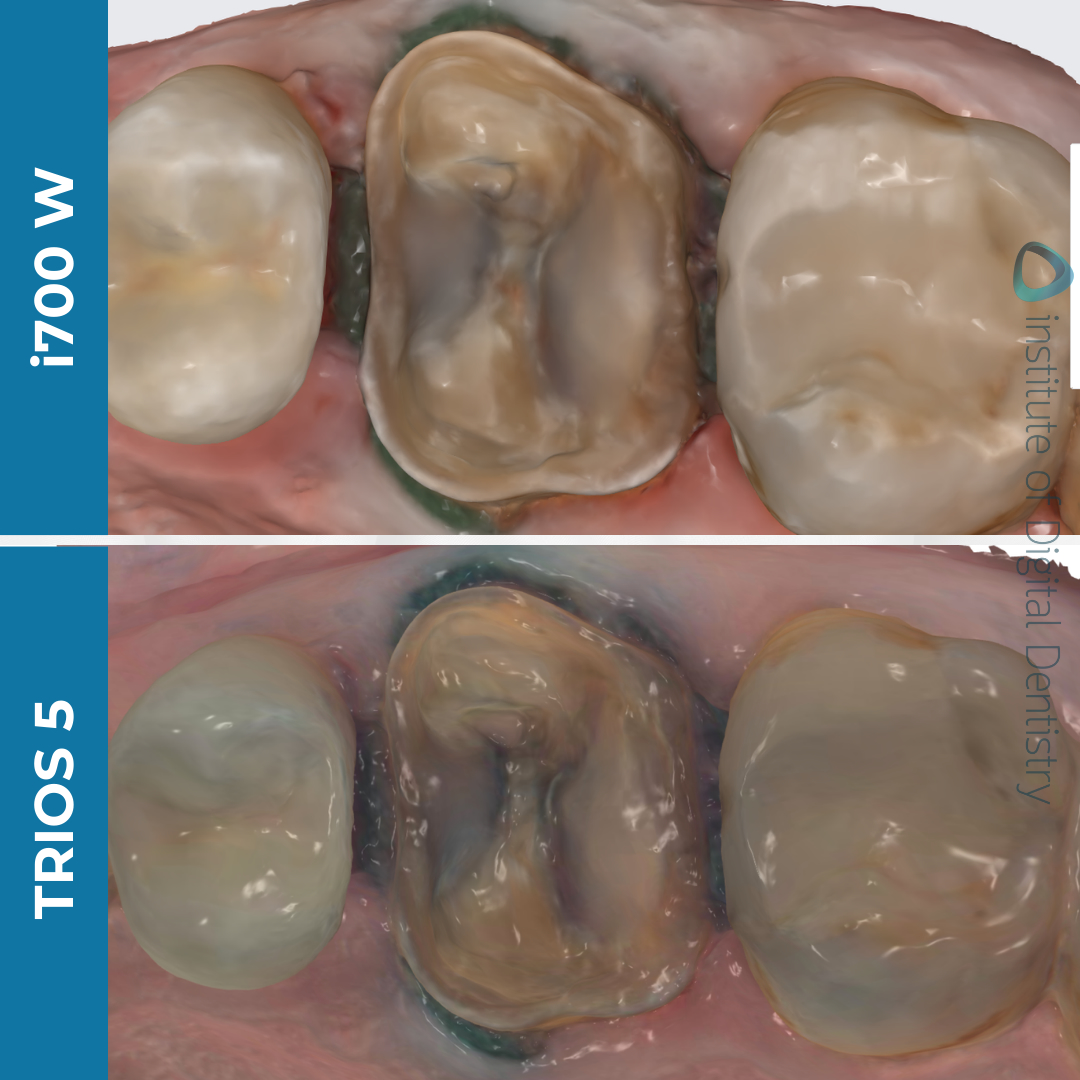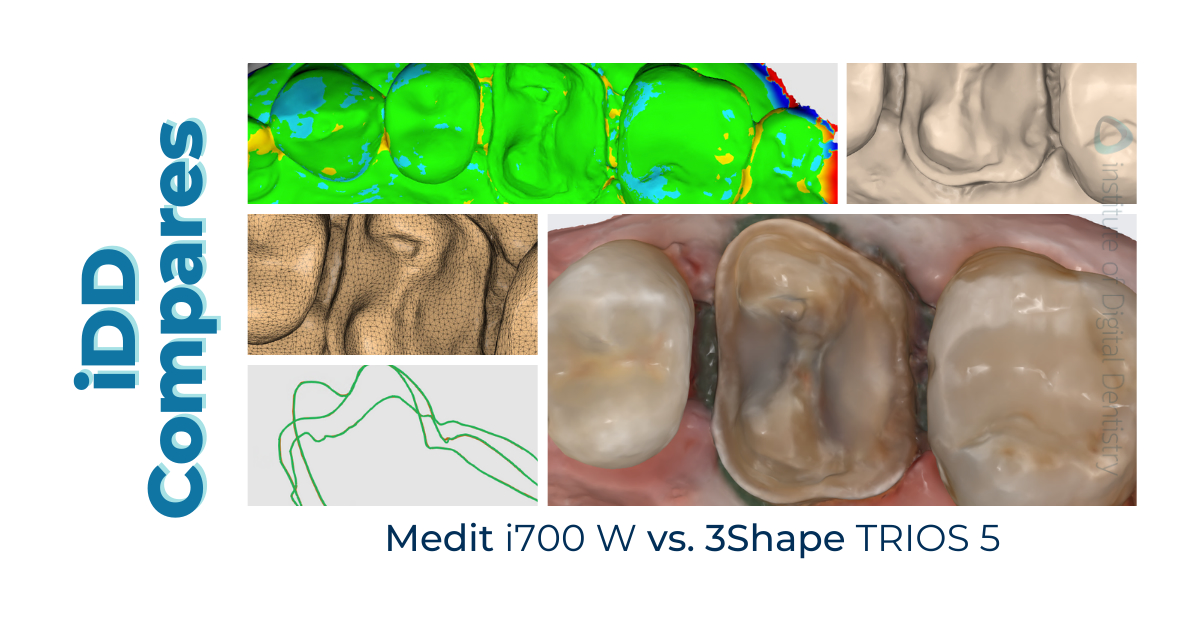iDD is back with another intraoral scanner compares!
With the introduction of Medit’s first wireless IOS in April 2022, the i700 Wireless, their latest flagship scanner as one of the most popular scanner options amongst dentists. Then five months later in September, 3Shape announced their newest flagship intraoral scanner (IOS), TRIOS 5.
Dr. Ahmad Al-Hassiny scanned his patient, 26 crown, on the same day with IOS from two prominent companies within the dental industry; i700 Wireless by Medit and TRIOS 5 by 3Shape.

I700 Wireless by Medit and TRIOS 5 by 3Shape.
It goes without saying that at the Institute of Digital Dentistry, we are very fortunate to have the opportunity to test all our intraoral scanners on real cases and real patients within a clinical environment. By doing so, we hope to provide an objective and honest review when comparing the performance of each intraoral scanner.
Here are the results of the individual scans - pictures of the color and monochrome scans, exported STLs, tessellated mesh, and close up of the prep margin to help you form your own opinion on these scanners.
Individual Scans in their Native Software
Every intraoral scanner available on the market is equipped with its own built-in scanning software. Most can eliminate scanning inaccuracies, such as movable soft tissues, cheeks, and tongue, using AI technology.
We can explore how these scanners capture color using their native software. The way each scanner captures color varies, mainly depending on the scanner's precision in interpreting light reflection from the prepared area and surrounding teeth.

The processed color scans of the same tooth preparation were captured using two different scanners, as previewed in their native software.
When we look at the processed color scans, there only seems to be a slight difference in scan brightness. TRIOS 5 appears to be less bright than the i700 W, however it does seem more capable to capturing the prep’s surface texture and detail as indicated by the various light reflections surrounding the 26 prep.
Monochromatic scans can also be taken and previewed in their native software. These scans provide a better view of the quality of the prep and is recommended to check for any scan issues that would not be as obvious when viewed in color.

The processed monochromatic scans of the same tooth preparation were captured using two different scanners, as previewed in their native software.
It is interesting to note that the prep margin is more distinct in the monochromatic i700 W scan in comparison to TRIOS 5’s monochrome scan. Although this could due to be differences within each scanner’s native softwares and rendering processes.
Exported Scans in Third-Party Software
The majority of intraoral scanners feature an open architecture, permitting scan exports for lab transmissions. These exports commonly come in one of three file formats - STL, PLY, or OBJ.
While STL files result in monochrome scans, OBJ and PLY files are capable of capturing and storing color and texture details. It's important to note, however, that not all intraoral scanners have the ability to export in the OBJ and PLY formats, while STL file export is a standard feature universally used across the market.
The scanners used in this iDD comparison are capable of exporting scans in the following formats:
i700 W - STL, PLY and OBJ
TRIOS 5 - STL and PLY
STL | PLY | OBJ | |
Medit i700 Wireless | 6 MB | 2.5 MB | 6.1 MB |
3Shape TRIOS 5 | 10.8 MB | 4.5 MB | - |
As STL files are quite simple, the higher resolution or encoding of larger-sized objects require more facets (triangles within the tessellation) to cover the 2D surface of the scan. We can see this with the larger STL file size of 3Shape’s TRIOS 5 scan, most likely an indication that more detail was captured in comparison to the i700 W.
Dental labs utilize independent CAD software solutions, in our case comparison, we used Medit Design, to view the exported STL, PLY, or OBJ files and design restorations based on these scans. This approach allows for an impartial viewing of the scans, independent of the individual scanner's native software, thereby bypassing any customized color or optimized surface rendering provided by the proprietary software.

All scans were exported in an STL format and previewed in the Medit Design app.
Scan Accuracy
Using Medit Design, we took a closer look at the amount and detail of data captured within each scan.
3Shape scanners are generally regarded as quality and accurate devices, with studies backing these claims, as well as correlating back to the larger STL file size mentioned in the previous chapter. This claim can also be corroborated through our own analysis of the tessellated mesh of the preps, up close. When we take a closer look, TRIOS 5 only just seems to possess the densest mesh, closely followed by i700 W. There are still yet to be any studies investigating the clinical significance of mesh density, but in this case, a denser mesh does not necessarily indicate a ‘better scan’.

Tessellated meshes of i700 W and TRIOS 5 scan as previewed in the Medit Design app.
Prep margin lines can also be reviewed using third-party software. Current intraoral IOS devices project a light source onto the surfaces to be scanned. For an accurate scan, it's crucial that this light is reflected to the IOS from the scanned surface. If, instead, the light penetrates the surface and does not bounce back, it results in inaccurate scans.
IOS devices tend to struggle with equi or subgingival preparations generally (but can be managed with proper tissue and moisture control), and you can see the margin is more prominent and easier to read with the i700 W, but only slightly.

Mesiopalatal prep margin of each scan as previewed in the Medit Design app.
Medit’s i700 Wireless was allocated as our point of reference in which we can view the deviations of the scans when aligned using Medit Design’s Deviation Display mode. Based on the colored deviation key, we can see that the scan meshes are -0.050 to +0.050 mm deviation in comparison to our reference. There seems to be minimal deviation around the prep area. This is also supported by the cross-section of the scans, in which we can see that there is minimal difference between the aligned scan data.

Deviation map of the i700 W scan as our point of reference when compared to the TRIOS 5 scan and sectional view.
Conclusion
While minor variations are just noticeable between Medit’s i700 Wireless and 3Shape’s TRIOS 5 intraoral scanners, either within their native software or third-party applications, no substantial deviation exists between all scans.
The accuracy in capturing the detail of the restoration prep may slightly differ depending on combination of the clinician’s scanning technique and the scanner itself, which could affect the end result of the dental lab technicians' restoration margin.
As with most of our prior reviews, it remains inconclusive whether the differences in scanner software and hardware significantly impact digital impressions. To reach a more definitive conclusion about the multitude of scanners available in the market, additional research within a controlled clinical environment is necessary.
Which IOS or type of cases would you like to feature in an iDD Compares?
Leave a comment below about what you’d like us to compare next.

